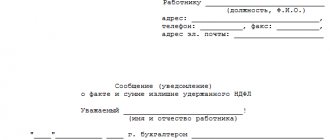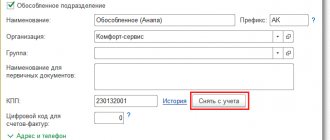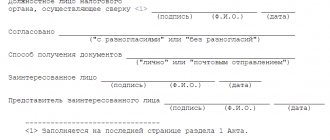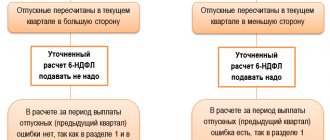Personal income tax is a special tax - it is transferred to the budget from the amount of income of an individual. This means that the employer must transfer to the budget exactly as much personal income tax as he withheld from the employee’s income. An organization acting as a tax agent does not have the right to pay tax at its own expense. What should you do if you calculated your tax incorrectly and withheld more? Or they made a mistake in the payment and instead of 1000 rubles, they transferred 10 thousand, can they be returned or offset?
A direct prohibition on paying personal income tax at the expense of an agent is specified in clause 9 of Art. 226 of the Tax Code of the Russian Federation: “Payment of tax at the expense of tax agents is not allowed, except for cases of additional assessment (collection) of tax based on the results of a tax audit in accordance with this Code in the event of unlawful non-withholding (incomplete withholding) of tax by a tax agent.”
In other words, personal income tax is not a tax that can be paid in advance for a year in advance. It is transferred to the budget every time income is paid to an individual. Why does overpayment still occur?
When may an overpayment of personal income tax occur?
An overpayment of personal income tax to the budget may occur when an organization that is a tax agent has excessively withheld and transferred to the budget personal income tax on amounts of income paid to an individual.
When an error in the calculation of personal income tax is identified and the taxpayer’s income is adjusted, the excessively withheld and transferred amount of personal income tax must be returned to the individual. And since the tax agent has already transferred this amount to the budget, then, accordingly, the organization must apply to the tax authority for a refund of overpaid personal income tax amounts.
Situations in which tax may be over-withheld are as follows:
- The employee received vacation in advance and quits. In this case, upon dismissal, the employer may withhold part of the overpaid vacation pay from the income due to the employee, but not more than 20% of the amount of these payments. The employee can return the rest voluntarily (this is where the over-withheld tax will appear). But if the employee refuses to return the vacation pay received in advance, then nothing can be done - the court in such cases takes the employee’s side, and there will be no excessive personal income tax withheld, because the employee kept the funds received for himself, which means he still received the income..
- If an error was made when calculating sick leave benefits and the employee was paid an inflated amount of benefits, then the Social Insurance Fund will not accept such amounts for credit. You will have to recalculate benefits and personal income tax. Again, the excess paid will either have to be withheld from income (but only in case of a counting error!) or the employee must be asked to voluntarily return the funds.
- When an employee is entitled to standard tax deductions, but he did not provide supporting documents in a timely manner . In such a situation, it is necessary to recalculate the tax base for personal income tax from the beginning of the year and an excessively withheld amount of tax may arise.
- If the employee receives a property deduction not from the beginning of the year. In this case, just as in the case of standard deductions, it will be necessary to recalculate the employee’s income from the beginning of the year and return the excess tax withheld.
- If the organization has a foreign employee working under a patent , then the previously withheld personal income tax will have to be returned if a notification of the right to reduce personal income tax on his income by the amount of fixed advance payments was received from the tax authority after the employer began paying such employee income .
- When personal income tax is incorrectly calculated at a higher rate or tax is withheld from non-taxable income.
How to reflect an overpayment of personal income tax in “1C: Salary and Personnel Management 8” (rev. 3)
In the “1C: Salaries and Personnel Management 8” program, edition 3, in the event of an overpayment of personal income tax, a number of actions should be performed to correctly reflect the transfer for individuals.
The procedure depends on whether there will be further personal income tax transfers to the tax authority before the 2-NDFL certificate is generated.
Let's look at the sequence of actions to obtain a correct 2-NDFL certificate in the 1C: Salaries and Personnel Management 8 program using an example.
Let’s assume that the organization has 2 employees with a salary of 10,000 rubles. In January 2022, when calculating salaries, personal income tax was calculated for each of them in the amount of 1,300 rubles. and transferred when paying salaries to the budget in a total amount of 2,600 rubles. In February 2022, one of the employees declared his right to standard tax deductions, and as a result of the recalculation of the tax from the beginning of the year to be transferred to the budget, an amount is calculated that takes into account the overpayment that occurred.
Example 1
| As a result of the recalculation of personal income tax, there is a certain amount to be transferred to the budget in February 2019. |
Note
Here and further in the examples under consideration, in the settings of the organization’s accounting policy for personal income tax (
Settings
-
Organization
- tab
Accounting policy and other settings
- link
Accounting policy
)
the Application of standard deductions on an accrual basis during the tax period is
.
In January 2022, employees of S.S. Gorbunkov and V.S. Ivy was charged 10,000 rubles, paid 8,700 rubles, and for each of them personal income tax was 1,300 rubles. transferred to the budget in the total amount of 2,600 rubles.
In February 2022, V.S. Plyushch applied for the provision of standard tax deductions for three children with the code from the beginning of the year:
- “126” for the first child - 1,400 rubles;
- “127” for the second child - 1,400 rubles;
- “128” for the third child - 3,000 rubles.
The total amount of standard deductions for 1 month is 5,800 rubles.
When calculating wages in the document Accrual of wages and contributions as a result of applying deductions for January and February in the amount of 11,600 rubles. There was an overpayment of personal income tax for taxpayer V.S. Ivy in the amount of 208 rub. (Fig. 1). According to employee S.S. Gorbunkov should be transferred 1,300 rubles. In general, 1,092 rubles should be transferred to the budget.
Rice. 1. Calculation of personal income tax in the document “Calculation of salaries and contributions”
The report Complete set of accruals, deductions and payments (Fig. 2) reflects the total amount of tax withheld in February 2022 - 1,092 rubles.
Rice. 2. Report “Full set of charges, deductions and payments”
When generating a payroll in the 1C: Salaries and Personnel Management 8 program, edition 3, the amount to be paid and the personal income tax to be transferred are separately generated for each individual (Fig. 3). Employee S.S. Gorbunkov should transfer the salary amount of 8,700 rubles. and transfer the calculated personal income tax of 1,300 rubles to the budget. Employee V.S. Ivy should transfer a salary of 10,000 rubles. You should not transfer personal income tax this month, since there is an overpayment left over from last month. According to employee V.S. Ivy registered a refund of the overpaid tax amount of 208 rubles. document Refund of personal income tax in the Taxes and contributions menu.
By default, in the document Statement to the Bank, in the Payment of salaries and transfer of personal income tax block, the Tax is transferred along with the salary flag is selected. Carrying out this document without preliminary analysis and changes to the default settings will lead to an error in the system: the program will register that the tax agent transferred an amount greater than required - 1,300 rubles. instead of 1,092 rub.
Rice. 3. Personal income tax to be transferred in the payroll
To avoid such a mistake, it is recommended to analyze personal income tax using reports every month after calculating wages before generating statements:
- Analysis of personal income tax by date of receipt of income;
- Analysis of personal income tax based on documents;
- Analysis of personal income tax by month.
The Remaining to be withheld field in these reports will indicate the actual amount of personal income tax to be withheld and transferred to taxpayers and to the tax agent in general.
Please note that the Remaining to Hold and Remaining to List fields do not appear in reports by default. They can be added by clicking the Settings button - Advanced view - Fields and sorting tab by checking the appropriate flags.
If there is a discrepancy between the amount to be withheld on reports and on payroll, you cannot use the default settings in payroll. In this case, you should disable the default Tax is transferred along with salary flag. Click the link Enter personal income tax transfer data to go to the document Personal income tax transfers to the budget. This document should indicate the correct amount of tax withheld and remitted for the entire organization. In Example 1 the amount to be transferred is 1,092 rubles. In this case, you can create a Register of transferred tax amounts using the Register of transferred personal income tax amounts button (Fig. 4) and make sure that the program correctly distributes personal income tax transfers.
After registering the transfer of personal income tax in the manner described above in the 2-personal income tax certificates generated for both employees, the tax calculated, withheld and transferred will be displayed correctly.
Rice. 4. Report “Register of transferred tax amounts”
How to return over-withheld tax to an employee
The procedure for returning personal income tax to an employee is specified in Art. 231 Tax Code of the Russian Federation.
After the accountant recalculates the tax and determines the over-withheld amount, he must inform the employee about it within 10 working days. There is no set form for reporting. Therefore, it can be drawn up in any form indicating the period of excess tax withholding, the amount of personal income tax to be refunded and a request to provide bank details for transferring the tax amount.
After receiving an application for a personal income tax refund from an employee indicating the details of the current account for transferring money, the employer has 3 months to return the personal income tax amount.
If the tax refund deadline is missed, it will need to be returned with interest, which is calculated for each calendar day of delay based on the refinancing rate of the Bank of Russia in effect on these days.
The tax must be returned only by bank transfer and only to the individual from whose income it was excessively withheld.
The tax is returned through current and future personal income tax payments for this and other employees. That is, instead of transferring personal income tax to the budget, you need to transfer the amount of over-withheld tax to a specific employee.
It may happen that the amount of personal income tax refund to an employee will be more than 3 months of the amount of calculated and withheld personal income tax for the entire organization. That is, in the next three months there may simply not be enough tax amount to be paid to the budget to refund the tax to the employee. In this case, you should contact the tax office for a refund. This must be done within 10 working days from the date of receipt of the application from the employee.
To do this, you need to prepare and send the following documents to the tax authority:
- application for refund of over-withheld tax;
- an extract from the tax register for the year in which excessive tax withholding occurred;
- documents confirming excessive withholding and transfer of tax amounts to the budget (in particular, copies of payment orders).
Within a month, the tax authority must transfer the money to the organization’s current account. And then it will be possible to transfer this money to the employee in the usual manner.
Also, the employer has the right to transfer money to the employee towards the return of personal income tax from his own funds, without waiting for the return of personal income tax from the budget. And then contact the tax office.
If an employee who has been found to have an excessively withheld amount of tax no longer works for the organization, he still needs to return the tax. The procedure is the same: you need to notify the former employee about the excess withholding, receive an application for a refund from him and transfer the amount of tax in the usual manner.
Overpaid personal income tax: indicate or not
There is no need to separately notify tax authorities about the refund of overpaid tax. This is not provided for by current tax legislation. After all, the refund is actually made against upcoming payments.
However, when filling out the calculation of the amounts of personal income tax calculated and withheld by the tax agent (Form 6-NDFL), these data must be indicated, the explanation emphasizes. Section 1 of form 6-NDFL should be filled out with a cumulative total for the first quarter, half a year, nine months and a year. Consequently, the total amount of personal income tax returned by the tax agent to the payer in accordance with the provisions of Article 231 of the Tax Code of the Russian Federation should also be reflected on an accrual basis from the beginning of the tax period on line 090 “Amount of tax returned by the tax agent.”
In turn, in section 2 of form 6-NDFL for the corresponding reporting period, you need to indicate only those transactions that were carried out over the last three months of this period.
Example:
The employee’s income in the organization for July, August and September 2016 amounted to 200 thousand rubles. The amount of personal income tax calculated from his salary for the 2nd quarter turned out to be equal to 26 thousand rubles (200,000 x 13%). The tax agent actually paid 25 thousand rubles to the budget, since he returned 1 thousand rubles to the payer as excessively withheld in the previous period.
Section 2 of the calculation of 6-NDFL for 9 months in this situation should be filled out as follows:
Lines 100-120 are the corresponding dates;
Line 130 “Amount of income actually received” - 200,000;
Line 140 “Amount of tax withheld” - 26,000.
The amount of 1000 that was returned to the employee is reflected on line 090 of section 1 of the calculation for the same period.
Let us remind you that the tax agent is obliged, upon a written application from the taxpayer, to return to him the overpaid amount of personal income tax. The law provides a three-month period for this.
A technical error
Overpayment of personal income tax can also arise as a result of a technical error - when the accountant indicated in the payment order that more personal income tax should be paid than was withheld from the employees’ income. That is, everything in accounting was calculated correctly, but for some reason, when transferring it to the budget, an error was made in the amount.
In such a situation, according to the explanations of the regulatory authorities, the amount of the overpayment must be returned to the organization upon its application, as erroneously transferred.
The procedure for returning such amounts is also regulated by Art. 78 of the Tax Code of the Russian Federation, since nothing else is established in the Tax Code of the Russian Federation, and tax agents also have the right to timely offset or refund of amounts of overpaid tax, and the rules specified in Art. 78 of the Tax Code of the Russian Federation, also apply to tax agents.
To return an overpayment for personal income tax, you need to provide the tax office with:
- application for refund of overpayment;
- documents confirming the overpaid amount of tax: certificates in form 2-NDFL, register of information on the income of individuals, payment documents confirming the fact of the overpaid tax.
That is, the tax agent must provide documents from which it will be clear that this overpayment is not tax amounts withheld from the income of individual taxpayers, but is precisely the organization’s funds erroneously transferred to the budget. It is recommended that before writing the application, you sign a personal income tax reconciliation report with the tax office. Then the tax authorities will make sure that all charges on the personal account (which were reflected on the basis of the 6-NDFL calculation) have been paid and the existing overpayment has actually been paid from the company’s funds and is subject to refund.
Form 6 personal income tax, return reflection
If such a situation arises, the accountant is faced with the question of how to correctly reflect the personal income tax return in 6 personal income taxes? You need to be guided by Section III of Appendix No. 2 to the Order of the Federal Tax Service dated October 14, 2015 N ММВ-7-11/ [email protected] In the event of a refund of overly withheld tax, its amount will be reflected several times, on the following lines:
- 070 – show personal income tax, including overpayment, withheld from the beginning of the year;
- 090 – the refund of previously incorrectly calculated tax to the employee is reflected;
- 140 – shows the amount of budget contributions accrued for the reporting quarter, which must be withheld from income.
The difference between lines 070 and 090 should correspond to the actual tax transferred. Both lines are filled in with a cumulative total from the beginning of the year.
Reflection of overpayment if the amount is returned in another period
When returned, personal income tax is reflected in line 090 in the reporting (tax) period in which it was transferred to the employee. The employer has 3 months to do this, so sometimes the periods in which the overpayment was made and returned do not coincide. How to reflect the personal income tax return in 6 personal income tax in this case?
Let's look at an example. From Petrova V.N. in June of this year, a tax was withheld in the amount of 3850 rubles, instead of 3550. The overpayment amounted to 500 rubles. The error was noticed only the next month, when a new reporting period began. The employee was transferred the money in August. The employee's income for the 3rd quarter amounted to 95,800 rubles, withheld tax - 12,454 rubles. In fact, 11,954 rubles were transferred to the budget. (12,454 – 500). An example of filling out a form for 9 months by line:
- 130 – 95 800;
- 140 – 12 454;
- 090 – 500;
- 070 – actual contributions to the budget that the tax agent has made since the beginning of the year, taking into account recalculation.
There is no need to submit an adjustment to the report for the previous period, but it is necessary to submit certificate 2 of personal income tax for the relevant employee.
Timely and correct reflection of the tax refund in the report will avoid suspicion on the part of the government body of incomplete payment of contributions to the budget by the enterprise.









